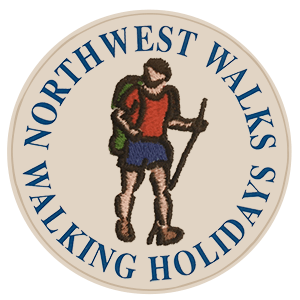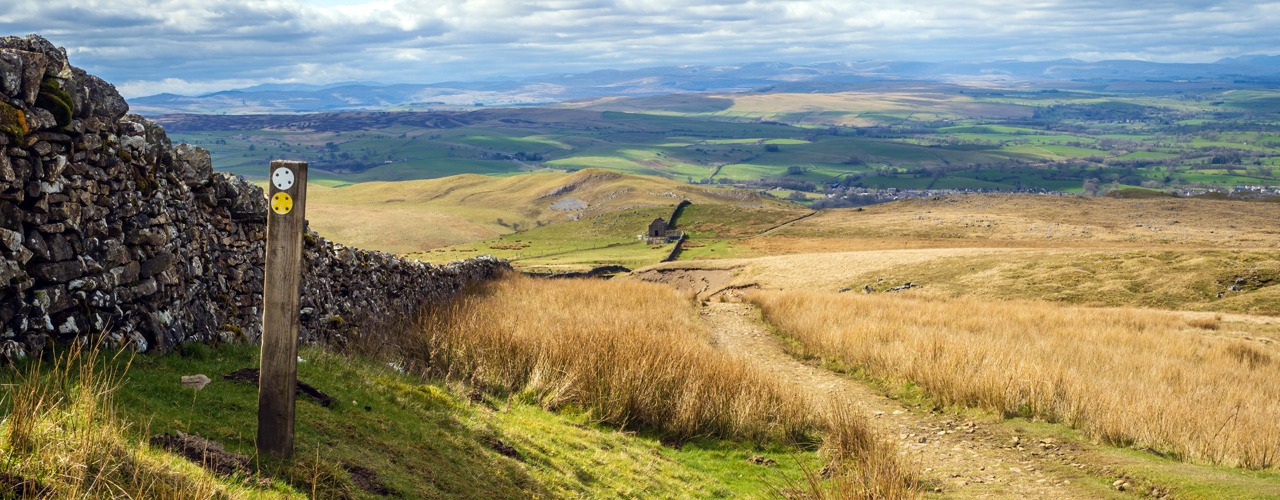Route Description
The Coast to Coast Part 2 (East) is a 110 mile route across North Yorkshire. The route is the Eastern half of Alfred Wainwright's famous coast to coast route. The following is intended to provide further information about the route and points of interest. Please note that all distances and heights in this document are approximate and along with all the other information are provided as an aid to describe the route. Several guide books providing more detailed route descriptions and information are available.
Terrain
The valleys through the middle section, and the arable land in the eastern section make for straightforward walking, but the hills of the Yorkshire Dales and North York Moors are rugged in places and some gradients can be steep. The terrain on this trail is a diversity of rocky mountain paths, limestone plateau’s, country lanes, rolling hillsides and farmland.
Waymarking and Navigation
Due to its popularity the route has recently become a National Trail. Waymarking is limited and navigation skills are required with a GPS, guidebook, map and compass. Waypoints for the route can be downloaded onto your GPS.
Kirkby Stephen
Kirkby Stephen is a small market town in the eden valley with a few pubs, cafes and shops.
Kirkby Stephen (180M) to Keld (350M). Distance 13 miles
Cross Franks Bridge and head for the lane which becomes a broad path onto the Pennine Moors and the summit of Nine Standards Rigg (662M). Depending on the time of year there are three routes over and around Nine Standards; green (avoiding the summit) for winter and spring, red for early summer, and blue for late summer and autumn. All routes cross peat, which is notoriously boggy in wet weather, before descending to the River Swale and the road in to Keld. If the weather is poor a road over the moor leads from Kirkby Stephen to Keld.
Keld (350M) to Reeth (200M). Distance 11 miles
From Keld you have a choice of routes. The main route stays high and crosses moorland that is scarred from a lead mining industry that disappeared at the end of the 19th century. From Keld the route descends to the river then climbs past Crackpot Hall and the ruins of Swinner Gill mine workings. It crosses the moor (580M) before dropping into Gunnerside Gill (400M) and then up onto Melbecks Moor (550M). From here a broad track descends gradually passing the ruins of Old Gang Smelting Mills to Surrender Bridge (350M) and another smelt mill. The last test of the day is to drop into Cringley Bottom, cross the river and then continue over the farmland to Reeth. The alternative route, which is very appealing if staying in Thwaite or Muker, is to follow the ‘royal road’ through Swaledale valley. The route passes through Gunnerside and a few small pleasant Yorkshire Dales villages.
Reeth (200M) to Richmond (150M). Distance 11 miles
This is a much easier day’s walk across rolling countryside passing Marrick Priory, Marske village and Whitecliffe wood to the largest town on route, Richmond.
Richmond (150M) to Danby Wiske (36M). Distance 13 miles
The route to Danby Wiske is almost level and generally easy going, it crosses farmlands to Bolton on Swale and then follows 7 miles of country lanes across the low lying Vale of Mowbray.
Danby Wiske (36M) to Ingleby Cross (80M). Distance 9 miles
The path remains easy going initially following the country lanes before returning to farm land. Take care crossing the busy A19 road.
Ingleby Cross (80M) to Clay Bank Top (250M). Distance 13 miles
This is the start of the crossing over the Cleveland Hills and the North York Moors, which are covered in purple heather during late summer months. The route follows the Cleveland Way trail and climbs steadily over Beacon Hill (299M) then descends into Scugdale (100M). Not keen to stay low the sometimes paved path climbs steadily at first then steeply onto Gold Hill (315M). It continues onto Carlton Moor (408M) before descending to Green Bank (300M). Once again it climbs going over Cringle Moor (430M), descends to 280M back up to 400M, down again to 300M and then a final climb through the Wainstones onto Hasty Bank (398M) before descending to the road at Clay Bank Top (250M). If all the up and down seems like too much hard work there is a path that contours round the hills from Green Bank to Clay Bank
Clay Bank Top (250M) to Blakey Ridge (400M). Distance 9 miles
There is a steep ascent to Carr Ridge (390M) followed by a gradual rise to the summit of Round Hill (454M), the highest point on the North York Moors. The path descends to Bloworth Crossing (400M) were it leaves the Cleveland Way and continues on an almost level disused railway line across the desolate moors to the remote Lion Inn on Blakey Ridge.
Blakey Ridge (400M) to Glaisdale (120M). Distance 10 miles
After a few miles alongside the road the route follows a track across the heather clad moors. Another road walk and then the route continues along a broad disused track gradually descending Glaisdale Moor into Glaisdale village.
Glaisdale (120M) to Grosmont (50M). Distance 4 miles
Never far from the River Esk the route passes through East Arnecliffe Wood to Egton Bridge where it follows a once toll road through the private estate of Egton Manor to Grosmont.
Grosmont (50M) to Littlebeck (50M). Distance 4 miles
The road climbs steeply out of Grosmont (its not called the 1 in 3 for nothing) to its high point on Sleights Moor (285M), there are wonderful views to Whitby and the sea. Still on heather moorland the route descends into Littlebeck (50M).
Littlebeck (50M) to Robin Hoods Bay. Distance 11 miles
The route follows a woodland trail. After the woodland the path rises and crosses a final stretch of heather moorland before following country lanes to the coast. This time the path turns south to follow a coastal path to Robin Hoods Bay and a final last descent to the sea. Follow tradition once more by dipping your boot in the sea and throwing your pebble in (that should baffle the geologists in years to come). Your challenge is complete.
Robin Hoods Bay
Robin Hoods Bay is a picturesque once fishing village and reputed smugglers haunt. Being built on the hillside the street from top to bottom of the village is the final steep descent/ascent on route.
More Information?
For more information or to make an enquiry, please don't hesitate to call or email us.


